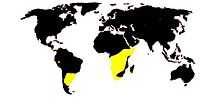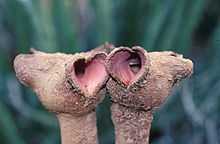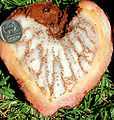Hydnoraceae
| Hydnoraceae | |
|---|---|
 | |
| Prosopanche americana | |
| Scientific classification | |
| Kingdom: | Plantae |
| (unranked): | Angiosperms |
| (unranked): | Magnoliids |
| Order: | Piperales |
| Family: | Hydnoraceae C.Agardh[1] |
| Genera | |
|
Hydnora | |
 | |
| Hydnoraceae distribution map | |
Hydnoraceae is a family of parasitic flowering plants in the order Piperales. It contains two genera, Hydnora and Prosopanche.[2] Prosopanche is native to Central and South America, while Hydnora can be found in desert regions of Africa, the Arabian Peninsula, and Madagascar.[2]
Description
The most striking aspect of the Hydnoraceae is probably the complete absence of leaves (not even in modified forms such as scales).[2] Some species are mildly thermogenic (capable of producing heat), presumably as a means to dispersing their scent.[3]
Morphology in pictures
-

Hydnora johannis, young plant in Um Barona, Wad Medani, Sudan.
-

Hydnora triceps, roots at Gemsbokvlei Farm, Wolfberg Road, southeast of Port Nolloth, South Africa, 2003
-

Flower of Hydnora africana in Karasburg District, Namibia, 2002.
-

Emerging flower of Hydnora africana in a desert dominated by Euphorbia mauritanica near Fish River Canyon, in the south of Namibia, 2000
-

Hydnora johannis in flower in Um Barona, Wad Medani, Sudan
-

Flowers of Hydnora triceps in Namaqualand, South Africa, 1999
-

Hydnora triceps, freshly cut fruit near Port Nolloth, South Africa, 2002
-

Hydnora triceps, hollowed out mature fruit near Port Nolloth, South Africa, 2002
Ecology
The plants are pollinated by insects such as dermestid beetles or carrion flies, attracted by the fetid odor of the flowers.[2] In Hydnora africana there are bait bodies with a strong smell, whereas in Hydnora johannis the scent comes from a region at the tip of the perianth called a cucullus.[2] The flowers may be above ground or underground.[2] The fruits have edible, fragrant pulp, which attracts animals such as porcupines, monkeys, jackals, rhinoceros, and armadillos, as well as humans. The host plants, in the case of Hydnora, generally are in the family Euphorbiaceae and the genus Acacia.[2] Those for Prosopanche include various species of Prosopis and other legumes.
Biochemistry
The plants contain high levels of tannins.[4]
Classification
Like many parasitic plants, the affinities with non-parasitic plants are not obvious, and 19th and 20th century botanists proposed a variety of placements for the family. Molecular data places them in the Piperales, more closely related to Aristolochiaceae than to Piperaceae or Saururaceae.[2][5]
References
- ↑ Angiosperm Phylogeny Group (2009). "An update of the Angiosperm Phylogeny Group classification for the orders and families of flowering plants: APG III" (PDF). Botanical Journal of the Linnean Society 161 (2): 105–121. doi:10.1111/j.1095-8339.2009.00996.x. Retrieved 2013-06-26.
- ↑ 2.0 2.1 2.2 2.3 2.4 2.5 2.6 2.7 Nickrent, D. L.; Blarer, A.; Qiu, Y.-L.; Soltis, D. E.; Soltis, P. S.; Zanis, M. (2002), "Molecular data place Hydnoraceae with Aristolochiaceae", American Journal of Botany 89 (11): 1809–17, doi:10.3732/ajb.89.11.1809, PMID 21665609
- ↑ Seymour, Rs; Maass, E; Bolin, Jf (Jul 2009), "Floral thermogenesis of three species of Hydnora (Hydnoraceae) in Africa", Annals of Botany 104 (5): 823–32, doi:10.1093/aob/mcp168, ISSN 0305-7364, PMC 2749535, PMID 19584128
- ↑ The Genus Hydnora
- ↑ Barkman, Tj; Mcneal, Jr; Lim, Sh; Coat, G; Croom, Hb; Young, Nd; Depamphilis, Cw (Dec 2007), "Mitochondrial DNA suggests at least 11 origins of parasitism in angiosperms and reveals genomic chimerism in parasitic plants" (Free full text), BMC Evolutionary Biology 7: 248, doi:10.1186/1471-2148-7-248, PMC 2234419, PMID 18154671